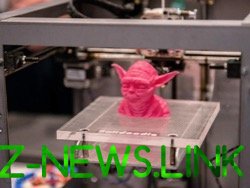
A wide proliferation of home 3D printers put before the lawyers question: what to do with the intellectual property rights in the print objects by the user in the home and whether printed objects considered duplicates?
Irina Tsvetkova, lawyer, founder of the service Platforma
Take, for example, a construction helmet. Today there are various technologies, such as 3D scanners, can be used to make almost any object to be digitized with the use of special software and materials to print on a 3D printer.
The resulting object is externally identical to the original, but through the use of a different material will have different physical and chemical properties.
Is it possible in this case to consider it a copy?
At the beginning of 2017, the company Adidas has announced plans to start production of sports shoes using three-dimensional printing. In April, the audience was presented to the first 300 pairs of sneakers Futurecraft 4D, the hallmark of which is the sole and mesh layer that was released with the help of innovative technology Primeknit on the three-dimensional printer.
After a few months the company Reebok introduced the world to a video in which the three-dimensional printer such as the chef of an expensive restaurant, conjuring an original dessert, printed sneakers from a material specially developed for this occasion by the company BASF. These shoes had to come into the market under brand Liquid Factory.
Several months passed with these presentations, but it is unlikely that someone today will point to a place where you can buy this innovative product. It simply is not selling.
And strangely enough, the same technology that created the hype around this Shoe tomorrow, at the same time inhibit its output to the mass market. The technology that used Adidas allows you to simultaneously print only six pads for the soles and this process takes 8 to 10 hours. About the mass production at such speeds cannot be considered.
Today unveiled the all their hopes related to Futurecraft 4D, imposes on the company Carbon promoting on the market of three-dimensional printing, known as digital light synthesizer (digital light synthesis). With its help Carbon promises to reduce the time required for the production of Futurecraft 4D to 20 minutes.
This sports shoes from both companies designed specifically for 3D printing (which is not true about building the helmet mentioned above) and, accordingly, each new printed pair will be considered as original.
In September of this year, it was announced that start-up, distribute items created on 3D printers Just3DPrint (Just Print It Inc.) lost the last of his three claims of Diplomatie filed in court in Philadelphia earlier in February against the web site 3dprint.com and its parent company 3DR Holdings (https://3dprint.com/186206/just3dprint-loses-lawsuit/). The plaintiff argued that as a result of articles, where the sale of items protected by copyright was presented as illegal, he suffered losses in the amount of $100 million, and demanded their compensation.
In the articles it was about a three-dimensional model SadFace (or Animalia). The copyright holder uploaded it to Thingiverse, but then found that it offered on sale at the store startup Just3DPrint on the trading platform ebay. After several complaints online store Just3DPrint was closed and this whole scandal has described in detail the website 3dprint.com by defining the activity of a startup as illegal.
This case is one of many startups when exploit loopholes in the laws on the protection of copyright for their own benefit. But the legislative process in this sphere is not in place in every country he goes his own way.
Russia
In the Russian law enforcement in the field of 3D printing there are three options: -models created technical by using existing intellectual property
model created by creative work without the use of objects of intellectual property
models created by technical means without the use of existing intellectual property.
In the first case, when receiving a 3D model of the scan or convert a two-dimensional image, the model is protected by copyright as the electronic copy used to scan the object. Although the question of the distribution of patent protection on 3D models of objects, the creation of which implemented patented solutions, can be answered in two ways.
In Chapter 72 of the Civil Code says about the use of patented solutions in the context of their implementation in the product or product than the 3D models are not.
But at the same time a 3D model that contains information about the patented solution makes possible a very simple manufacture of the product or products by any person.
Accordingly, the spread of such models, including via the Internet contrary to the interests of patent holders.
In the second case, the model is developed in a graphical editor, a designer, she is an independent work and rights to it belong to its author.
In the third – when you scan or convert images that are not subject to intellectual property created models are not protected by copyright. But at the same time, the 3D model can be registered as an industrial design and to self-protection in a new way.
In the Russian legislation, unfortunately, does not stipulate the cases when the model is created as a result of complex calculations when you are scanning a group of objects and development of information on mutual location of thousands of points in space. It is logical that the Creator of such a model is interested in the legal control of this information.
However, in such cases, perhaps the use of norms related rights of the maker of the database.
Due to the fact that the law allowed free use without consent of the owner of copyright and patent rights for personal use, most likely interpretation of the norms of use for personal use shrink and it will undergo some changes in the foreseeable future.
USA
In the U.S. there are several forms of intellectual property. For example, patents, which in turn are divided into patents on the use and design patents, bear a low risk for users of 3D printers. And here’s why.
Usually the patent holder in the event of violation of his rights requires to rectify the situation and thereby bring the case to court. Moreover, he understands that in the case of 3D printing, where rights have been violated by private users for their own needs, and not for the purpose of material gain, any trial would be economically unjustified, and potential compensation will not even cover legal costs.
Normally a trial in the sphere of violation of patent law in America lasts at least three years and costs upwards of $ 3 million in addition it is not easy to identify the offender in connection with the established tradition in the Internet community of fans of 3D printing to go online under false names.
In the case of the copyright the risk may be higher, although they apply only to the original, not copies. It is worth considering that unlike patents and trademarks that need to apply copyright come into force from the moment of creation of unique works and are not only in the life of the author, but for 70 years after his death.
The country also has the copyright Law in the digital age (Digital Millennium Copyright Act) under which the web sites created for downloading any copyright (e.g. YouTube), are not liable for copyright infringement by users.
Instead, they are required to create a mechanism for owners of copyright, which is activated in the event of violations. As with patent law, the act gives a guarantee to those who download files for 3D printing from the Internet that the copyright holder will not go directly to court, but first will inform the user about copyright infringement.
Unlike patent law, where it is necessary to prove not only breach, but also causing damage, deliberate copyright infringement shall entail the payment of compensation to $150 thousand.
Risk when copyright infringement is comparable with the risk arising from the violation of trademark rights. But the cost of the proceedings and necessary for the court the amount of evidence here, playing into the hands of individual violators.
Asia (Hong Kong)
In October 2014, the 28-year-old Japanese, Aritomo Imura was sentenced to two years ‘ imprisonment for the manufacture of firearms on a 3D printer and the dissemination of this technology through the Internet (https://3dprint.com/20019/sentence-imura-3d-printed-gun/ ).
As often happens with new technologies, users are so overwhelmed those advantages which they inflict, that they forget about the legal liability associated with their use.
An example of this can be the story of the once popular file sharing service Napster, which is distributing the audio files, infringe the copyright of performers and were eventually closed.
In Hong Kong a lot of publicity in 2007, received the case of Hong Kong BitTorrent HKSAR vs Chan Nai Ming (http://www.bileta2007.co.uk/papers/images/stream_6/WeinsteinS_WildC.pdf ). Chan, spreading through the network of BitTorrent movies, has violated the license law and for it eventually landed behind bars.
In Hong Kong, the intellectual property is governed by the copyright Act (cap 528), which apply to both the original object and the file to computer modeling (CAD), necessary for 3D printing. It is considered that even if such a file is in the public domain, but protected by various licenses, its application to copy the subject matter involves copyright infringement.
Patent law in Hong Kong is governed by the patents Act (Chapter 514) and specify that the registration of a patent in any other geographic region does not imply its action in Hong Kong. Similarly, the law treats trademarks and registered designs.
But at the same time in Asian jurisdictions are actively discussing the need for refinements and additions, caused widespread 3D printing.
For example, if a private user, quite legally printed on a 3D printer the same construction helmet, but then during its operation was injured, who must be responsible? The manufacturer of the printer, for which this helmet was printed, or the developer of the CAD file that was used to produce this helmet.
Also there are discussions around ethical issues, especially when printing, medical organs and implants.
As we can see the wide spread of 3D printing raises many questions among lawyers around the world and despite the fact that there is a common tendency in the interpretation of precedents concerning the observance of intellectual property rights in 3D printing, there is an urgent need for additions and clarifications in the regulatory laws in the interests of right holders and users.
© 2017 – 2019, paradox. All rights reserved.





